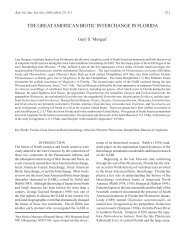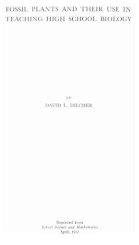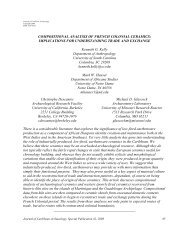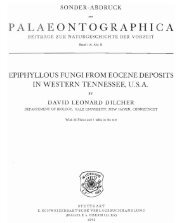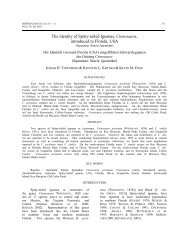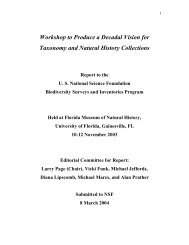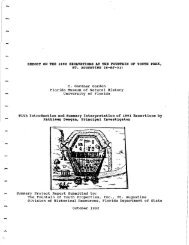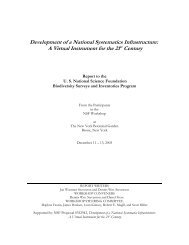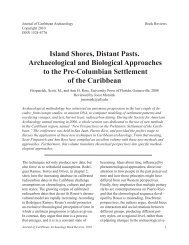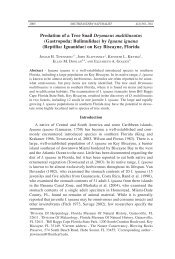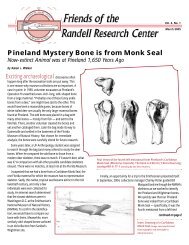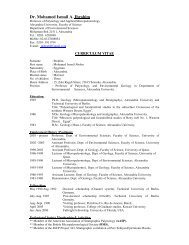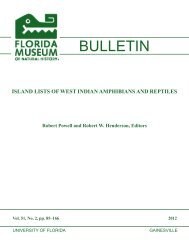Early angiosperms from the Lower Cretaceous of Jixi, eastern ...
Early angiosperms from the Lower Cretaceous of Jixi, eastern ...
Early angiosperms from the Lower Cretaceous of Jixi, eastern ...
Create successful ePaper yourself
Turn your PDF publications into a flip-book with our unique Google optimized e-Paper software.
Angiospermae<br />
Dicotyledonae<br />
G. Sun, D.L. Dilcher / Review <strong>of</strong> Palaeobotany and Palynology 121 (2002) 91^112 97<br />
Genus Asiatifolium Sun, Guo et Zheng, 1992<br />
Type: Asiatifolium elegans Sun, Guo et Zheng<br />
emend.Sun et Dilcher<br />
Generic diagnosis: Leaf pinnately compound, rachis<br />
nearly straight.Lea£et oblong to obovate;<br />
apex obtuse to rounded; base cuneate.Margin<br />
entire.Petiole chartaceous.Venation pinnate, brochidodromous;<br />
midvein stout.Secondary veins 5^<br />
8 pairs, nearly opposite.Tertiary and quaternary<br />
veins nearly equal in thickness.Submarginal vein<br />
present.<br />
Asiatifolium elegans Sun, Guo et Zheng emend.<br />
Sun et Dilcher<br />
Plate I, 1^11; Plate III, 8^10; Fig.4A^C<br />
Synonyms:<br />
1992a Asiatifolium elegans Sun, Guo et Zheng; Sun et al., p.<br />
546, pl.I, ¢gs.1^3.<br />
1992a Chengzihella obovata Guo et Sun; Sun et al., p. 546,<br />
pl.I, ¢gs.4^9.<br />
1995 Asiatifolium elegans Sun, Guo et Zheng; Sun, p.429,<br />
pl.141, ¢gs.1^3, text-¢g.9^2, 1^2.<br />
1996 Asiatifolium elegans Sun, Guo et Zheng; Sun and<br />
Dilcher, p.393, pl.1, ¢gs.1^9, text-¢g.1A^B.<br />
Emended description: Leaf pinnately compound,<br />
rachis nearly straight, rachis about 0.6^1.0 mm<br />
in thickness.Lea£et obovate (oblanceolate), usually<br />
1.9^4.8 cm (minimum = 0.7 cm) long by 1.1^<br />
2.0 cm (minimum = 0.3 cm) wide; margin entire;<br />
apex obtuse, <strong>of</strong>ten slightly rounded.Leaf lamina<br />
partly asymmetrical, tapering gradually to form a<br />
slight to pronounced asymmetrical base.Petiole<br />
medium length ca. 1.0 cm long by 0.7 mm wide.<br />
Petiolule very short 2.0 mm long by 1.0 mm wide,<br />
appearing to be in£ated.Venation pinnate; midvein<br />
conspicuous with a pronounced taper in<br />
width towards <strong>the</strong> apex (base 0.5 mm to apex<br />
0.1 mm) and straight to slightly curved. Secondary<br />
veins appear subopposite with branching<br />
more or less irregularly, at 40^50‡ angle <strong>from</strong><br />
midvein, secondary veins fork equally in <strong>the</strong> outer<br />
1/3 <strong>of</strong> <strong>the</strong> lamina and may continue to fork two or<br />
three times forming a network that eventually<br />
joins a sub-marginal vein.Few or no intersecondary<br />
veins.The tertiary venation and quaternary<br />
venation <strong>of</strong>ten arising at 90‡ angles.Ultimate venation<br />
preserved, appearing to form a closed network<br />
<strong>of</strong> areole.An evident marginal vein (ca.0.1<br />
mm wide) present just inside <strong>of</strong> <strong>the</strong> leaf margin by<br />
about 0.2 mm.<br />
Discussion: The new material (Plate I, 7;Fig.4B)<br />
provides more complete characters <strong>of</strong> <strong>the</strong> leaf<br />
which is actually compound, not simple as indicated<br />
in Sun et al.(1992a).The marginal veins,<br />
present just inside <strong>the</strong> leaf margin by a very short<br />
distance, can be regarded as one <strong>of</strong> <strong>the</strong> main characters<br />
<strong>of</strong> <strong>the</strong> present species.Regarding <strong>the</strong> loops<br />
near <strong>the</strong> margin described by Sun et al.(1992a, p.<br />
546), <strong>the</strong>y seem to be very obscure and would best<br />
be regarded as a sector <strong>of</strong> <strong>the</strong> marginal vein.Since<br />
<strong>the</strong> main characters <strong>of</strong> Chengzihella obovata (Sun<br />
et al., 1992a, p.546, pl.I, ¢gs.4^9) are consistent<br />
with <strong>the</strong> present species, <strong>the</strong> former should be incorporated<br />
into <strong>the</strong> present species.<br />
Material: More than 20 specimens.<br />
Locality and horizon: Chengzihe <strong>of</strong> <strong>Jixi</strong>, Heilongjiang,<br />
China; Chengzihe Formation in <strong>the</strong> W-B<br />
Section beds Nos.29, 42, 45 and 47.<br />
Plate I.All <strong>of</strong> <strong>the</strong> specimens described here are collected <strong>from</strong> <strong>the</strong> <strong>Lower</strong> <strong>Cretaceous</strong> Chengzihe Formation <strong>of</strong> <strong>Jixi</strong>, Heilongjiang,<br />
China, and are housed in Nanjing Institute <strong>of</strong> Geology and Palaeontology, Academia Sinica, Nanjing, China.<br />
1^11. Asiatifolium elegans Sun, Guo et Zheng emend.Sun et Dilcher.<br />
1, 2.PB16766.1.Bar = 0.5 cm.2.Bar = 1 cm.<br />
3, 10.PB16771.3.Bar = 1 cm.10.Bar = 0.5 cm.<br />
4, 5. PB16772.4.Bar = 1 cm.5.Bar = 0.5 cm.<br />
6.SC10011.Bar = 0.5 cm.<br />
7.SC10013.Bar = 0.5 cm.<br />
8.SC10012.Bar = 0.5 cm.<br />
9.PB16768.Bar = 1 cm.<br />
11.Venation <strong>of</strong> <strong>the</strong> leaf and showing <strong>the</strong> intramarginal vein in detail <strong>of</strong> 9.Bar = 0.2 cm.



